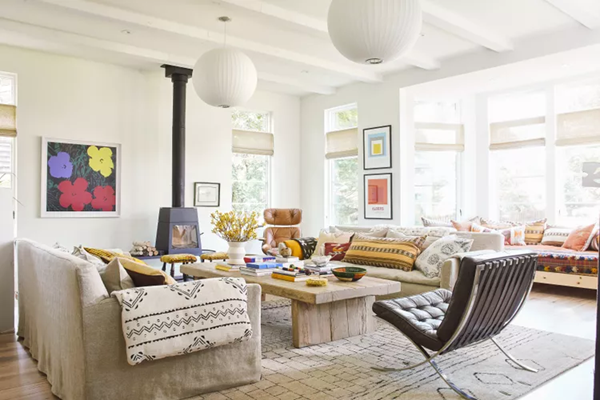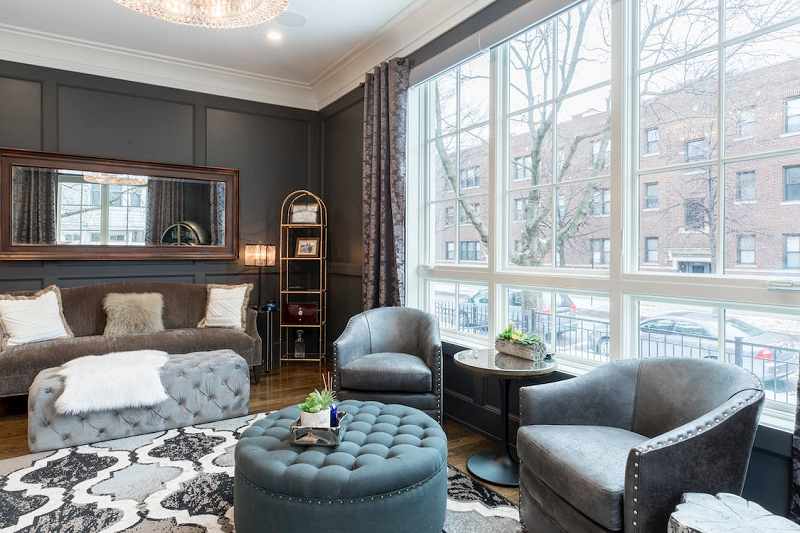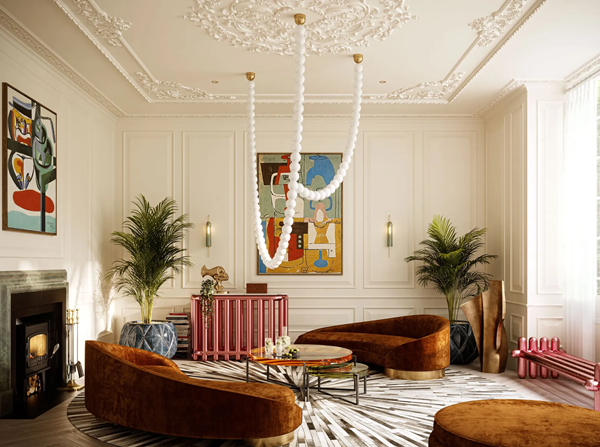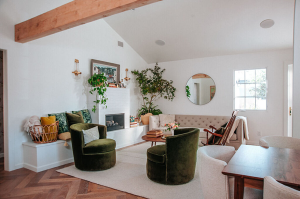How to mix fabric patterns can be a complicated task, but it can also be a lot of fun. When done correctly, it can create a stylish and unique look that will turn heads. However, it’s important to know how to mix patterns properly, or you could end up with a look that’s too busy or mismatched.

In this blog post, I’ll discuss the basics of mixing fabric patterns, including how to choose complementary patterns, how to balance the scale of your patterns, and how to avoid common mistakes. We’ll also provide some tips for styling your mixed-pattern outfit.
What’s Pattern Maxing?

Pattern mixing is the art of combining fabrics with different patterns to create visually appealing and harmonious designs. It’s a technique that goes beyond simply matching colors or patterns; it’s about understanding the interplay of scales, colors, and pattern styles to create a cohesive and balanced look.
Pattern mixing allows you to express your creativity and personal style, adding a touch of whimsy, sophistication, or bold individuality to your projects, whether it’s transforming your home décor with a vibrant mix of florals and geometrics or elevating your wardrobe with a playful blend of stripes and polka dots. The possibilities are endless, limited only by your imagination.
“Pattern mixing is like playing music. You need some high notes, some low notes, and a few pauses in between.”
Justina Blakeney, founder of Jungalow
Mastering the Fundamentals of Pattern Mixing

Before you move forward on your pattern-mixing journey, it’s essential to grasp the foundational principles that lay the groundwork for a harmonious blend of fabrics.
Scale:
Consider the size of the patterns you’re mixing. Pairing large-scale patterns, like bold florals or geometric prints, with smaller-scale patterns, such as delicate stripes or polka dots, creates a dynamic and visually engaging look. Imagine a cozy fall throw pillow adorned with a large-scale paisley pattern, complemented by a contrasting smaller-scale paisley pattern in a complementary color. The interplay of scales adds visual interest without overwhelming the overall design.
Color:
Harmony is key when it comes to color. Choose fabrics that share a common color palette or utilize color theory to create a visually pleasing contrast. For instance, consider a living room accent wall showcasing a bold floral pattern in shades of blue, green, and white. To complement this pattern, consider incorporating solid fabrics in varying shades of blue or green, or introduce a complementary color, such as orange or yellow, through accent pieces like throw pillows or curtains.
Pattern Style:
The world of patterns is vast, encompassing florals, geometrics, stripes, and a myriad of other styles. Understanding the characteristics of different pattern styles is crucial for harmonious pattern mixing. Florals bring a touch of nature and femininity, while geometrics add a modern and edgy vibe. Stripes offer a classic and versatile option, while animal prints exude boldness and sophistication.
Related Post: How to Decorate with Earthy Colors
Steps On How To Mix Fabric Patterns Properly

Are you ready to turn into a pattern mixing pro.? Well, let’s delve into the fundamentals, and explore practical tips, techniques, and provide ample inspiration for your next pattern-mixing adventure.
1. Start with a neutral base.
The key to mixing fabric patterns is to start with a neutral base. This will help to ground the look and make it less overwhelming. Choose a neutral color for your walls, furniture, and flooring, and then you can start adding in pops of pattern.
Related Post: How To Decorate a Desk at Home
2. Choose patterns that work well together.
The first step on how to mix fabric patterns is to choose complementary patterns. This means choosing patterns that have similar colors, textures, or shapes. For example, you could pair a floral print with a geometric print in the same color family. Or, you could pair a striped fabric with a textured fabric in a complementary color, or a striped pattern with a polka dot pattern.
When choosing complementary patterns, it’s also important to consider the scale of the patterns. If you’re mixing two large-scale patterns, the look can be overwhelming. To balance the scale, try mixing a large-scale pattern with a small-scale pattern. Or, you could mix a geometric pattern with a floral print.
“If you are looking for a way to style your space with wall art without breaking your piggy bank, then I recommend reading “10 Surprising Benefits of Printable Wall Art”
3. Balance the Scale of Your Patterns
Another important tip on how to mix fabric patterns is to balance the scale of your patterns. This means making sure that the patterns are not too overwhelming or too small. To balance the scale, try mixing a large-scale pattern with a small-scale pattern. Or, you could mix a geometric pattern with a floral print.
4. Avoid Common Mistakes
There are a few common mistakes that people make when mixing fabric patterns. One common mistake is to mix too many patterns. When you mix too many patterns, the look can be overwhelming and chaotic. To avoid this mistake, try mixing only two or three patterns in your outfit.
Related Post: Western Gothic Design: Embracing Rustic Charm for the Modern Pioneer
Another common mistake on how to mix fabric patterns that clash! This means mixing patterns that have very different colors, textures, or shapes. To avoid this mistake, try to choose patterns that have similar colors, textures, or shapes.
5. Add pops of color.
If you’re feeling bold, you can add pops of color to your mix of fabric patterns. This is a great way to add interest and personality to a room. Just be sure to choose colors that work well together, and don’t go overboard with the color.
“Think outside the box, but start with basics. Stripes, florals, and geometrics are your friendly neighborhood neutrals.”
Emily Henderson, Decorator and author
Don’t Be Afraid To Experiment

How to mix fabric patterns is all about having fun and experimenting. Don’t be afraid to try new things and see what you like. The best way to learn is by doing, so get out there and start mixing!
Here are some additional tips on how to mix fabric patterns properly:
- Use a color wheel to help you choose colors that work well together.
- Consider the size of the room when choosing patterns. A small room can be overwhelmed by large-scale patterns, so choose smaller patterns instead.
- If you’re not sure how to mix patterns, start with a simple pattern and add more patterns as you get more comfortable.
- Don’t be afraid to mix different types of fabrics, such as cotton, linen, and wool.
- Play around with different combinations until you find a look that you love.
With a little bit of planning and effort, you can easily mix fabric patterns to create a stylish and unique look for your home. So what are you waiting for? Get started today!
“Don’t be afraid to mix scales! A large-scale floral paired with a tiny polka dot can create a dynamic and playful effect.”
Nate Berkus, Decorator and television personality
How to Mix Fabric Patterns in Different Rooms of Your Home
The Living Room

The living room is the heart of the home, a space where families gather, friends socialize, and memories are made. It’s a place where comfort and style intertwine, creating an ambiance that reflects the personality and preferences of those who inhabit it. When it comes to pattern mixing in the living room, the possibilities are endless. From bold florals adorning accent walls to playful polka dots dancing across throw pillows, each pattern brings a unique touch of personality to the space.
Related Post: How to Choose The Right TV Size to Decorate Your Living Room
Imagine a living room where a plush velvet sofa, adorned with a medley of geometric patterns, serves as the anchor piece. A vibrant floral rug stretches across the floor, its rich hues harmonizing with the sofa’s intricate designs. Throw pillows, each boasting a distinct pattern, add layers of visual interest, creating a dynamic interplay of textures and colors. Sheer curtains, delicately embroidered with a repeating floral motif, allow sunlight to filter through, casting a soft glow upon the patterned tapestry.
- Start with a neutral base: Choose a solid-colored sofa or armchair as your anchor piece. This will provide a calming backdrop for your pattern-mixed accents.
- Incorporate a variety of scales: Combine large-scale patterns, such as bold florals or geometrics, with smaller-scale patterns, such as delicate stripes or polka dots. This will add visual interest and prevent the space from feeling too busy.
- Use a common color palette: Choose fabrics that share a common color palette to create a cohesive look. For example, you could mix blues, greens, and whites, or neutrals with pops of color.
- Layer patterns: Layer patterns to create depth and dimension. For instance, you could place a patterned rug under a solid-colored sofa, and then add patterned throw pillows and curtains.
The Bedroom

The bedroom, a sanctuary of tranquility and relaxation, invites pattern mixing to create a soothing and personalized retreat. Opt for patterns that evoke a sense of serenity, like delicate florals in pastel hues or subtle geometrics in calming shades. Embrace the comfort of soft textures, incorporating velvet duvet covers, linen bedspreads, and cozy knitted blankets.
Related Post: Best Pro Tips To Decorate a Guest Bedroom
Picture a bedroom where a canopy bed, draped in a flowing floral pattern, serves as the centerpiece. The walls are adorned with a soothing watercolor wallpaper, its gentle washes of color creating a tranquil backdrop. Throw pillows, each featuring a unique floral design, adorn the bed, adding pops of color and texture. Sheer curtains, embroidered with delicate floral motifs, allow soft sunlight to filter through, casting a warm glow upon the patterned haven.
- Create a calming atmosphere: Choose patterns that are soothing and relaxing. Avoid using too many bold or busy patterns, as this can make the space feel overwhelming.
- Embrace soft textures: Incorporate soft textures, such as velvet, linen, or chenille, to create a cozy and inviting space.
- Mix patterns with solids: Balance patterns with solids to prevent the space from feeling too busy. For example, you could use a patterned duvet cover with solid-colored sheets and curtains.
- Use color to evoke a mood: Choose colors that evoke the mood you want to create in your bedroom. For example, blue can be calming and relaxing, while green can be refreshing and revitalizing.
The Dining Room

The dining room, a space for gathering and sharing meals, welcomes pattern mixing to create a vibrant and inviting atmosphere. Embrace patterns that evoke a sense of joy and conviviality, incorporating playful stripes, cheerful polka dots, or whimsical florals.
Related Post: Best Pro Tips to Create a Focal Point in a Room
Imagine a dining room where a rustic wooden table, adorned with a colorful floral tablecloth, serves as the focal point. The walls are painted in a warm and inviting shade, providing a neutral backdrop for the vibrant patterns. Dining chairs, each upholstered in a unique geometric pattern, add a touch of personality and visual interest. Patterned curtains, featuring playful stripes or cheerful polka dots, frame the windows, adding a touch of whimsy to the space.
- Add a touch of whimsy: Pattern mixing can add a touch of whimsy and personality to your dining room. Choose patterns that you love and that make you feel happy.
- Consider the scale of your dining table: If you have a large dining table, you can use larger-scale patterns. If you have a smaller dining table, you should use smaller-scale patterns.
- Mix patterns with tableware: Incorporate patterns into your tableware, such as plates, bowls, and napkins. This is a fun way to add a touch of personality to your table setting.
- Use color to create a festive atmosphere: Choose colors that are festive and inviting. For example, red can be a great choice for a holiday dinner party.
The Home Office

The home office, a space for creativity and productivity, demands pattern mixing that stimulates the mind and energizes the spirit. Choose patterns that are bold, geometric, and thought-provoking, incorporating elements of nature, technology, or abstract art.
Related Post: How to Create a Cozy Home Office
Picture a home office where a sleek desk, adorned with a geometric pattern, serves as the centerpiece. The walls are painted in a refreshing shade of blue, providing a calming backdrop for the bold patterns. Accent chairs, each upholstered in a unique geometric design, add a touch of personality and visual interest. Patterned curtains, featuring abstract art or nature-inspired motifs, frame the windows, adding a touch of inspiration to the workspace.
- Create a stimulating environment: Choose patterns that are stimulating and energizing. Avoid using too many calming or relaxing patterns, as this can make you feel sluggish.
- Incorporate geometric patterns: Geometric patterns can be a great choice for a home office, as they can add a sense of order and focus.
- Use pops of color: Add pops of color to your home office to brighten up the space and boost your mood.
- Mix patterns with office supplies: Incorporate patterns into your office supplies, such as notebooks, pens, and folders. This is a fun way to add a touch of personality to your workspace
“The key to successful pattern mixing is to find common threads. Look for repeating colors, textures, or even shapes to tie everything together.”
Joanna Gaines, designer and television personality
Most Popular Post:
10 Surprising Benefits of Printable Wall Art
15 Must-Have Accessories For Styling A Coffee Table
How to Choose the Perfect Interior Color Scheme for Your Home
Expert Guide On How To Buy A Rug For Each Room
Conclusion:
Embrace the world of mixing fabric patterns, where personal style meets endless creativity to craft beautiful and balanced spaces. Dive into the basics of scale, color, and pattern types, and unlock practical tricks like mood boards, color harmony, pattern repetition, grounding with solids, adding textured charm, and expert fabric matching and layering.
Embrace the challenge of mixing patterns with different textures for home décor, and let your imagination run wild as you transform your living room, bedroom, or kitchen into a haven of patterned delight. Discover how to mix patterns for different projects, from casual chic outfits to formal elegance, and embrace seasonal flair with pastel florals, jewel tones, tartans, and snowflakes.
How to mix fabric patterns properly is a journey of self-expression, so experiment, have fun, and create spaces that reflect your unique style. With the right approach to how to mix fabric patterns, you can transform your world into a canvas of patterns and textures that truly speaks to your heart.
How To Mix Fabric Patterns-(FAQs)
Q: What is pattern mixing?
A: Pattern mixing is the art of combining fabrics with different patterns to create visually appealing and harmonious designs. It’s a versatile technique that can add visual interest, create a unique style, and allow for personal expression through home décor and fashion projects.
Q: What are the basic principles of pattern mixing?
A: There are three basic principles to keep in mind when pattern mixing:
- Scale: Combine large-scale patterns, such as bold florals or geometrics, with smaller-scale patterns, such as delicate stripes or polka dots. This will add visual interest and prevent the space from feeling too busy.
- Color: Choose fabrics that share a common color palette to create a cohesive look. For example, you could mix blues, greens, and whites, or neutrals with pops of color.
- Pattern style: Understand the characteristics of different pattern styles to create a harmonious blend. Florals bring a touch of nature and femininity, while geometrics add a modern and edgy vibe. Stripes offer a classic and versatile option, while animal prints exude boldness and sophistication.
Q: What are some tips for mixing patterns with different textures?
A: Here are some tips for mixing patterns with different textures:
- Layer textures: Layer fabrics of different textures to add depth and dimension. For instance, you could place a patterned rug under a solid-colored sofa, and then add patterned throw pillows and curtains.
- Contrast textures: Create a dynamic and engaging look by contrasting textures. For example, consider a modern bedroom retreat where a crisp linen duvet cover is complemented by throw pillows featuring a combination of soft velvet and chunky knit accents.
- Balance textures: When mixing patterns with different textures, it’s essential to maintain balance and prevent visual overwhelm. Incorporate solid fabrics in neutral tones to serve as a grounding element, allowing the textured patterns to shine without creating a sense of chaos.
Q: How to mix fabric patterns in different projects, such as living room, bedroom, dining room, and home office?
A: Here are some tips on how to mix fabric pattern for different projects:
- Living room: Start with a neutral base and incorporate a variety of scales, using a common color palette. Layer patterns and add pops of color to create a vibrant and inviting atmosphere.
- Bedroom: Choose soothing and relaxing patterns, embrace soft textures, and balance patterns with solids to create a calming and inviting retreat. Use color to evoke a mood that promotes relaxation and tranquility.
- Dining room: Add a touch of whimsy with playful patterns, consider the scale of your dining table, mix patterns with tableware, and use color to create a festive and inviting atmosphere.
- Home office: Choose bold, geometric patterns that stimulate the mind, incorporate elements of nature, technology, or abstract art, and add a touch of inspiration to the workspace.
Q: What are some common mistakes to avoid when pattern mixing?
A: Here are some common mistakes to avoid when pattern mixing:
- Using too many patterns: Too many patterns can make the space feel overwhelming and chaotic. Choose a few well-coordinated patterns to create a cohesive look.
- Choosing patterns with too much contrast: Patterns with too much contrast can create a jarring effect. Instead, choose patterns that share a common color palette or have similar tones.
- Ignoring scale: Using patterns of all the same scale can make the space feel monotonous. Mix large-scale patterns with smaller-scale patterns to add visual interest.
- Not grounding the space with solids: Incorporating solid fabrics in neutral tones can help to ground the space and prevent the patterns from feeling too overwhelming.
- Using patterns that you don’t love: Pattern mixing should be a fun and expressive experience. Choose patterns that you love and that make you feel happy.
CATCH THE LATEST IN HOME DECOR TRENDS:

Steal These 15 Expert-Approved Decorating Secrets

How To Accessories Your Living Room

Small Space? 10 Ways To Make A Room Appear Bigger

Make Your space Look Expensive
GET CAUGHT UP ON ALL THE INSPIRING DECOR TIPS:

18 Fresh Decorating Ideas To Update Your Fireplace

How To Create An Art Gallery Wall
